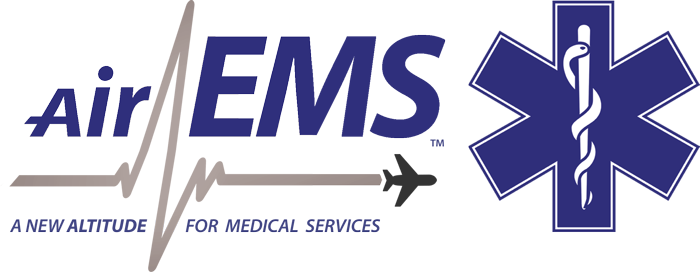FAQ
GENERAL FAQ
How do I schedule a transfer and how much notice is required?
- Patient’s Name
- Date of Birth
- Current Medical Condition / Diagnosis
- Sending and receiving facility information
- Preferred date and time for travel
- Insurance information or other method of payment
- If applicable, passport information for patient and passenger
The process only takes a few minutes. From here, Air EMS will manage communications between facilities, physicians, case managers, admission personnel, airports and ground ambulances. For emergent cases (as deemed by the sending physician), air ambulance arrangements can often be made within 2 to 4 hours.
For non-emergent and international transports, Air EMS requests a minimum of 24 hours notice to allow time to obtain all necessary documents and insurance approval (if applicable). For international travel, additional factors may regulate the amount of time necessary to prepare for transport such as passport/visa requirements, international permits and landing arrangements, etc.
Are you licensed and insured?
Can you fly to me prior to picking up the patient?
Will Air EMS transport Transplant Organ(s), Patients and/or the Procurement Teams?
MEDICAL FAQ
Who will provide the patient care?
All medical crew members have a minimum of 4 years Critical Care experience in addition to training/certification in:
- Basic Life Support (BLS)
- Advanced Cardiac Life Support (ACLS)
- Pediatric Advanced Life Support (PALS)
- Trauma – Advanced Trauma Life Support (ATLS) audit, TNCC/TNATC or equivalent
Additional training is provided in areas such as advanced ventilator support, infection control, stress recognition/management, hazardous materials, flight physiology as well as EMS rules and regulations to ensure all medical personnel are well educated with the necessary skills.
What equipment and medications are on board the aircraft?
- FAA approved stretcher system
- Oxygen
- Cardiac monitor/defibrillator
- Advanced airway management equipment including intubation equipment, ventilator, bi-pap, airway equipment, portable suction and bag-valve mask resuscitators
- Full ACLS drug complement and IV solutions
- Specialty equipment necessary to meet the patient need
Are there patients Air EMS cannot transport?
- High-Risk Obstetrical: High risk obstetrical (HROB) is defined as: active labor with imminent delivery possible during flight, dilation > 4 cm, unstable trauma with pregnancy, active vaginal bleeding, active preterm labor, or any condition defined by the sending or receiving physician as high risk.
- Neonatal: Neonatal patients are those less than 28 days old or less than 37 weeks’ gestational age and requiring an isolette and/or warmer.
- Pediatric less than 5 kgs which requires (or is anticipated to require) ventilatory support during transport.
The following patient types and/or conditions require special consideration prior to acceptance.
- Equipment: Orthopedic patients with special equipment needs must be evaluated prior to flight acceptance to ensure the patient can be safely loaded, secured and transported. Patient size (length, width and height) and weight must be measured. Any devices such as traction, splints or other orthopedic devices will be evaluated for proper use and securing prior to flight.
- Hazardous Materials (HAZMAT): Generally, patients exposed to hazardous materials cannot be transported due to lack of decontamination resources for the aircraft. Only decontaminated patients may be transported. A decontaminated patient is defined as one who has undergone the standard decontamination procedures as outlined for a specific contaminant. All contaminated clothing and belongings will remain at the scene.
- Ebola virus disease (EVD), Active Tuberculosis: To ensure the safety of the patient, crew and general public, these patient transports will be completed utilizing the Iso Ark, a specialized containment unit, and protective gear. Personnel conducting these transports must have completed the training on this device prior to transport and methods to disinfect the aircraft post-flight.
- Non-ambulatory patient weight exceeding 350 pounds or height exceeding 78 inches: Based on manufacturer recommendations and loading restrictions of the aircraft, any non-ambulatory patient exceeding 350 pounds or 78 inches in height will be evaluated prior to acceptance to ensure the patient can be safely loaded and secured inside the aircraft.
Can patients with infectious disease concerns be transported?
What is a Commercial Medical Escort?
- Provide the necessary medical equipment and ensure medication for comfortable transport.
- Obtain required medical clearances from the airline prior to departure.
- Coordinate and assist the patient with airport security processes, aircraft boarding, flight connections and deplaning.
- Coordinate with sending and receiving facilities medical staff.
- Schedule ground transportation to/from the airport.
- Coordinate with designated family members during the transport.
What is Commercial Stretcher Service?
Restrictions do apply. To ensure this mode of transportation is safe and appropriate for the patient, a detailed medical assessment is completed prior to scheduling the trip. Currently, no US-based carriers (American, Delta, US Airways, United, etc.) offer this service. Due to space restrictions, privacy may be of concern for many travelers.
Commercial stretcher service requires detailed coordination to ensure all clearances are obtained. Approximately 5 – 7 days will be required to ensure all arrangements are made prior to transport.
AIRCRAFT FAQ
What type of aircraft do you use and how do you determine which aircraft is used?
Air EMS utilizes various aircraft types and models to ensure safety and maximum comfort for the patient – including the popular Citation, Learjet and Hawker models. Regardless of the aircraft selected for a transport, all aircraft are FAA Certified, pressurized and configured in a manner that allows continuous access for patient care while ensuring the safety of the patient, passengers and crew.

